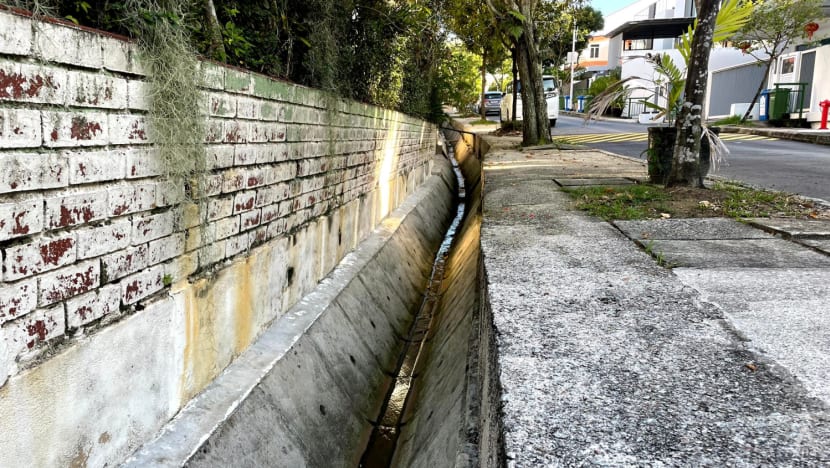Woman sues town council after falling into drain: What can you do if this happens to you?
What should you do if you fall into a drain and want to seek compensation? CNA speaks to lawyers about possible courses of action.

An open drain. (File photo: CNA/Vanessa Lim)
SINGAPORE: Last month, a 71-year-old woman sued Holland-Bukit Panjang Town Council for more than S$33,000 in damages after falling into an uncovered drain and sustaining injuries.
The trial concluded on Sep 19, with a verdict pending.
What can you do if you're in a similar situation and want to seek compensation? CNA speaks to lawyers about the possible courses of action.
FIRST STEP: SEE A DOCTOR
The first thing to do is to seek medical care, said Mr Muhammad Razeen Sayed Majunoon, associate at Advance Law.
"Turning to the courts is not the best option to start with. You may ask your lawyer, or by yourself, try writing to the relevant authorities or organisations to ask for compensation," he said.
Public liability insurance would usually cover such situations, said Mr Razeen.
The claimant should obtain a medical report detailing the extent of injuries suffered, prognosis and if any follow-up treatment is required, said Mr Tang Shangwei, partner in specialist and private client disputes and white collar and enforcement practices at WongPartnership.
One of the ways to seek compensation would be to seek damages by bringing a claim under the tort of negligence, said Ms Alyssa Mundo, associate director at Tembusu Law.
KEEP RECORDS
To do that, first ensure you have the correct documentation and evidence. Make a record of the scene of the incident by photographing it comparatively to show the size of the gap or areas which are uncovered, said Mr Tang.
The person should keep the receipts of payments made for medical treatments, transport to and from medical treatments and devices bought as a result of the injury such as walking sticks and crutches, said Ms Choo Yean Lin, partner at Tan Lee & Partners.
This can also include the documentation if you needed to engage a helper because of the incident.
"In other words, gather as much information as possible to boost your case," said Ms Choo.
Other evidence to gather include those pertaining to losses that occurred due to the injury, such as a broken phone and loss of earnings, said Mr Razeen.
IDENTIFY THE ENTITY RESPONSIBLE
The next step would be to identify which entity or entities are responsible for the management, maintenance and upkeep of the property where the drain is located, said Mr Tang.
This may include the managing agents, engaged cleaning contractor or other contractors responsible for the space.
Generally, national water agency PUB is responsible for the drains in Singapore, said Mr Razeen.
The agency needs to check the drains regularly and perform maintenance where necessary.
"In some instances, home owners or businesses might be responsible for the drains within their properties. If you are injured falling into a drain, it is essential that you record where the incident happened to help identify who your claim will be made against," said Mr Razeen.
If the claimant is not sure who has management or control over the relevant drain, the claimant may consider making an application in court to compel a party to disclose information or documents, said Mr Suang Wijaya, partner at Eugene Thuraisingam LLP.
This would be for the purpose determining who is the proper party to sue, he said.
ESTABLISH CONTACT
The claimant may first consider engaging in legal correspondence with the entity in charge of the drain, said Mr Wijaya.
"Such correspondence would be to explore whether parties may amicably settle the dispute without court litigation," he said. "If there is no amicable settlement, the claimant may have to consider the prospects of commencing litigation against the other party."
The claimant will have to prove that they were owed a duty of care by the defendant, said Mr Razeen.
"For example, if you fell into a drain at your workplace (business premises), your employer might have been negligent," he said, pointing to the Work Injury Compensation Act.
SOLUTIONS OTHER THAN COURT
Before heading to court, a person can try other avenues first. These include mediation, a recognised form of alternative dispute resolution in Singapore, said Mr Tang.
"With the assistance of an independent mediator, the parties in dispute can work towards reaching an amicable resolution to the matter," he said.
"If a settlement is reached, the matter ends there. However, if a resolution cannot be obtained, the claimant can still proceed with the court process."
A claimant can also seek an insurance payout from his or her own insurance, but this does not preclude him or her from seeking compensation from the party responsible for the injuries, said Mr Tang.
A personal accident plan may provide coverage for such incidences, said Ms Mundo. She added that a town council may also have its own insurance policies to cover situations where such accidents take place within premises under the town council’s control and responsibility.
WHICH COURT TO HEAD TO?
It is the claimant who chooses which court to commence proceedings in, and the proper court in turn depends on the amount of damages they are claiming for, said Mr Wijaya.
The Magistrate's Court can award damages of up to S$60,000, while the District Court can award damages of up to S$250,000, lawyers told CNA. In the case of road traffic accident claims or claims for personal injuries arising from industrial accidents, a District Court can award sums of up to S$500,000, said Mr Razeen.
Damages of above S$250,000 can be awarded by the High Court, the lawyers said.
The amount of damages claimed would depend on the extent of injuries or financial losses sustained by the claimant, said Mr Wijaya.
The compensation amount can be calculated based on two types of damages, said Mr Razeen: General damages for things like pain, suffering and loss of amenities, and special damages like medical costs, travel expenses and loss of income.

For workplace injury claims under the Work Injury Compensation Act, the time limit to make the claim is within a year from the incident, said Mr Razeen.
The time limit for other personal injury claims is within three years from the incident, he added.
WHAT ARE THE CHANCES OF SUCCESS?
Asked to comment on the chances of success, lawyers CNA spoke to said each case is different and it depends on the facts and circumstances of each case.
The defendant can argue that the claim should fail or be significantly reduced for multiple reasons, said Mr Wijaya.
These include: That the defendant does not owe the claimant a duty of care, that the defendant has complied with the standard of care, that the claimant's injury was not caused by the defendant's actions, that the claimant was himself careless and contributed to his own injury, or that the compensation asked for is excessive.
The court will assess whether a duty of care was owed to the claimant, whether there was a breach of this duty of care and if so, whether it resulted in the claimant's injuries, said Mr Tang.
In determining the appropriate standard of care the defendant is held to, several factors will be considered including: The likelihood and risks of harm caused by the hazard, the extent of harm, the costs of avoiding the harm and the industry standards and common practice, he added.
Even if the claimant succeeds, the court will have to determine if there was any contributory negligence on the claimant's part that resulted in the injuries, said Mr Tang.
Explaining further, Mr Razeen said the amount of damages may be reduced if the claimant is found to be contributorily negligent.
"For example, if you fell into the drain because you were practising your parkour moves and thus ended up in an accident, the court may reduce the amount of damages (i.e. monetary compensation) you can claim substantially (or you may even be fully liable for your own injuries), as compared to if you had fallen into the drain because the drain was not covered properly," he said.
However, if a claimant is injured despite taking reasonable care to prevent the accident from occurring, it is most likely that the damages would not be reduced substantially, said Mr Razeen.

Factors that may work against the claimant include whether there were any safety measures or signs put in place, the size or visibility of the hazard and whether the claimant ought to have been aware of the hazard, said Mr Tang.
The court will also consider whether the incident could have been avoided if the claimant paid more care and attention.
PAST CASES
There have been cases where an amicable settlement was reached between parties after the lawsuit commenced, said Mr Wijaya. These include a woman who sued PUB for S$5 million after falling into a manhole.
Most suits nowadays are settled privately during mediation, with the terms confidential, said Ms Choo.
If, for example, a claimant is found to be 30 per cent liable such as in the case of a claimant who jaywalked and got into a motor accident, he would get only 70 per cent of the award, she said. For example, he would get S$70,000 if the award is S$100,000, after deducting 30 per cent.
"Applying that to the case of falling into the drain, if for example, there is CCTV footage of the claimant blatantly disregarding his or her own safety and taking the risk, and that resulted in him or her falling in the drain, then the claimant needs to take some blame and thus will only get the awarded sum less the liability that the court says he or she will bear," said Ms Choo.
Mr Tang gave the example of a resident of the Equatorial condominium, who successfully sued the management corporation for negligence after he slipped on a puddle of water and oil in the car park of the estate.
The High Court found the claimant to be 75 per cent liable for his own injuries due to his own negligence, he said.
In another case, a 68-year-old man successfully sued Vicom Inspection Centre after he fell into a 2m-deep pit at the Bukit Batok inspection centre, said Mr Tang.
The court found that the claimant was careless and had failed to keep a proper lookout, which resulted in the fall. He was awarded only 10 per cent of the damages which were to be assessed.
Mr Tang said the liability of a party depends on the facts of the case. The entity itself or its agents are ultimately responsible for the management, maintenance and safety of the space, he said.
"At the same time, the users themselves have to bear responsibility and care for their own actions."


















